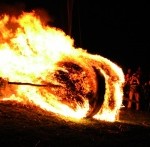
From the name to the bunny, it’s all German. The name Easter was first appropriated by the Christian calendar. First it was the pagan festival Ostara, celebrated on the vernal equinox, around March 21 in the Northern hemisphere. Ostara was named for the pagan goddess of spring, Eostre. According to legend, she once saved a bird whose wings had frozen during the winter by turning it into a rabbit. Because the rabbit had once been a bird, it could lay eggs. And so it became the Easter Bunny.
The bunny as a symbol for Easter is first mentioned in writings in 16th century Germany. The first edible Easter bunnies, made of pastry and sugar, were also produced in Germany in the early 1800s. Around that time, children made nests of grass and settled them in their parents’ spring gardens for the Easter Bunny to fill during the night with brightly decorated eggs. Another great tradition is beautifully displayed by the Sorbs, a Slavic minority at home in the federal states of Saxony and Brandenburg, who skillfully hand-paint Easter eggs and offer them for sale at the Easter markets. Pennsylvania Dutch settlers brought the Easter bunny to America in the 1700s. Their children, who used their hats or bonnets to make their nests, believed that if they were well behaved, the Oschter Haws (literally Easter Hare) would fill their upturned headgear with colored eggs. The Easter egg hunt remains as much a tradition in German towns and cities as it is on the White House lawn in Washington, D.C. Children race to find the Bunny’s colorful eggs across the world every year.
 In Germany, Easter is also celebrated with a few unique traditions varying from region to region like Osterfeuer (Easter bonfire), Osterräder Rollen (Burning Easter wheels rolling; photo) and Ostereiersuchen (Easter egg hunt):
In Germany, Easter is also celebrated with a few unique traditions varying from region to region like Osterfeuer (Easter bonfire), Osterräder Rollen (Burning Easter wheels rolling; photo) and Ostereiersuchen (Easter egg hunt):
Easter Egg Rolling
There are a few regional variations though, for example an egg-rolling custom called “Eiertrüllen” in northern Germany, the search for Easter water or looking for eggs in a manner known to Goethe. In the region of East Fresia in the north of the country the Easter eggs are rolled or thrown from hills and the slopes of dykes, or knocked together otherwise. The low German term for the pastime is Eiertrüllen. Children love to compete against each other, letting their eggs run down sandy hillocks – the winner is the one whose egg arrives at the bottom in one piece.
Easter Eggs & Goethe
In Weimar a local custom recalls the author Johann Wolfgang von Goethe, who lived in the area for decades. Once a year on Green Thursday he would invite children into his garden where he had hidden eggs for them to find. Weimar maintains the tradition to this day and invites youngsters to search for Easter eggs in the Park on the river Ilm where Goethe’s residence stands.
Fetching Easter Water
An extremely unusual Easter customer is being sent to fetch Easter water. According to local myth, such water has magical qualities and promotes both health and beauty. This only applies if liquid is taken from a body of flowing water and is brought straight into the home and the person delivering it is not even allowed to talk while doing so.
Source: German National Tourist Board – www.germany.travel
——————————————————————————————————————————-